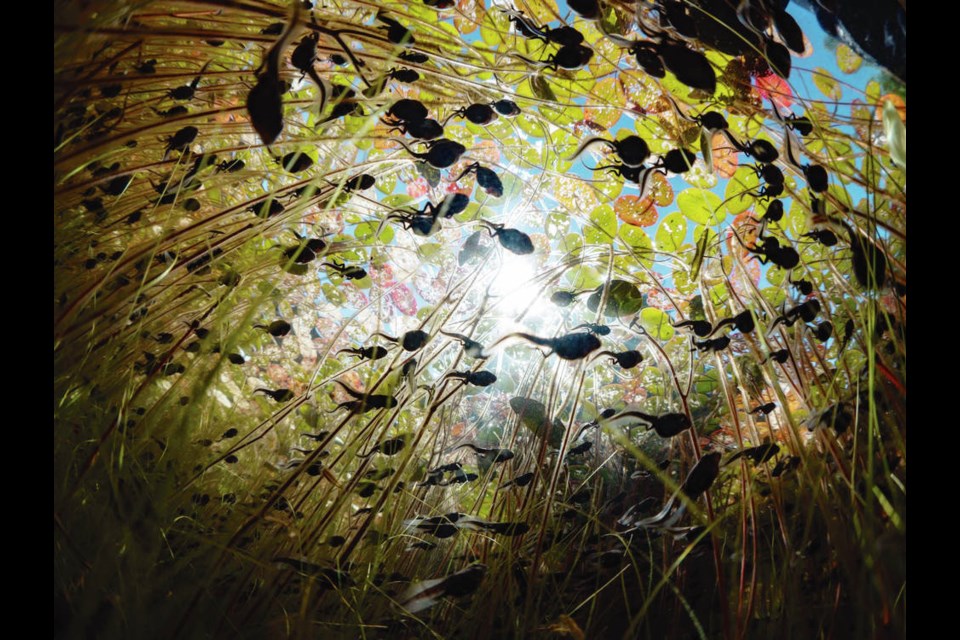Maxwel Hohn slips silently into a secluded lake on central Vancouver Island strewn with lilypads and fallen logs.
Camera rolling, he descends into the clear water, meandering along aquatic trails cut by beaver, and then starts to capture the magic.
Millions of plump tadpoles appear — clouds, Hohn calls them — moving en mass in their remarkable daily migration from the depths of the lake to its oxygen-rich shallows where they feed on algae to support the metamorphosis to western toad.
The Royston-based filmmaker and expert diver spent four years filming the tadpole’s incredible daily journey, between June and July, and this fall released Tadpoles: The Big Little Migration, a mini documentary on this crucial phase of life for the toad, a designated threatened species in British Columbia under constant threat from urban development, logging and vehicle traffic.
Every summer, Hohn has been camping and patiently filming the tadpoles, accumulating what is considered the most comprehensive video of the western toad tadpole.
Hohn doesn’t reveal the location of the lake, fearing this delicate portion of the toad’s life cycle could be disrupted by extra humans.
Hohn recruited fellow filmmaker Russell Clark to write and edit the documentary, and fellow videographer Steve Woods to help frame the story with additional footage.
The eight minute mini-nature video has already attracted considerable online attention with more than 21,000 views on YouTube in the first two weeks.
Hohn called filming the eight-week underwater metamorphosis of the tadpole — from little black bulb with a tail to a toad with four legs and a respiratory system “a passion project.”
“Documenting almost the entire life cycle of an animal is rare, challenging and lots of fun,” he said. “The guessing game of figuring out the daily routine of the tadpoles required patience and a healthy dose of curiosity in order to ‘think’ like a tadpole. For me as a photographer, I really wanted to document each of those moments to share everything I’ve learned from observing these fascinating little creatures.”
Hohn said he developed a “strong emotional bond” with the tadpoles, noting large eyes and “permanent smiles” as well as their perseverance amid predators such as water bugs and leeches.
They swim an incredible gauntlet every day, starting in the deeper part of the lake in the morning, working their way toward the shallows to feed on micro plants. They congregate in “clouds” and use lily pads as cover from predators during their journey. A few hours later, they turn around and do the same route in reverse. The tadpoles repeat this daily migration throughout their metamorphosis.
The small toadlets eventually emerge from the water and into the forest, where they face an uncertain, often perilous future. After habitat loss due to agriculture, logging and other developments, being run over by vehicles is considered a major threat.
In areas such as Whistler and Chilliwack, tunnels have been built to aid in their migration. The Pacific Rim National Park Reserve recently built three tunnels under the highway between Tofino and Ucluelet designed to aid amphibians.
Hohn and his team estimate a “mind-blowing” three million tadpoles are in the lake. “A friend compares it to the migration of wildebeest moving across the Serengeti, but on a tiny scale. … It was humbling and heartwarming,” he said.
Clark, who wrote and edited the documentary, said the film carries a deeper message. “This story shows us that no matter how small you are, if you keep swimming, you’ll lead to great things,” said Clark. “There’s been no better time to share this kind of story with the world.”
He said Hohn’s dedication to the project was incredible.
“Producing a mini-nature documentary is a long task,” said Clark. “This has been a self-financed labour of love for Maxwel for the last four years, and it shows. The footage is incredible, and unique. No one has ever told this story in video before — not the BBC, not National Geographic, no one.”
Hohn’s ultimate goal is to have globally renowned broadcaster and natural historian David Attenborough narrate some of his work.
Born on the Sunshine Coast and living in the Comox Valley for the past seven years, Hohn, 32, had been enrolled in film school but took off travelling when he was 17. Travelling in Honduras, Vietnam, Norway, Greece, the Bahamas, and Tanzania helped sharpen his skills to become one of Canada’s leading nature photographers.
He has contributed video to the BBC, National Geographic, Discovery Channel, various B.C. tourism organizations and won Best In Show at the 2018 Monterey Shootout.
Hohn has logged more than 3,500 hours underwater, a significant amount of time considering divers are constrained by physical limitations and weather.
He usually flips between freshwater dives in the summer and ocean filming in the fall and winter months. He’s currently filming the giant octopus in Discovery Passage and sea lions and seals near Hornby Island and Powell River.
“The octopus are very shy,” said Hohn. “They are nocturnal and stay in their dens during the day, so they are tricky to film.”
Sea lions also have their challenges, and are intimidating. he said. “They have the same jaw structure as a grizzly. A 2,000-pound bull can swim directly at you, and then divert. They sometimes chew on your fins.”
Hohn said he feels lucky to be filming underwater. “When you walk in the forest, everything flees from you. Marine life gets curious. They want to check you out.”
dkloster@timescolonist.com
Tadpoles: The Big Little Migration from Maxwel Hohn on Vimeo.



